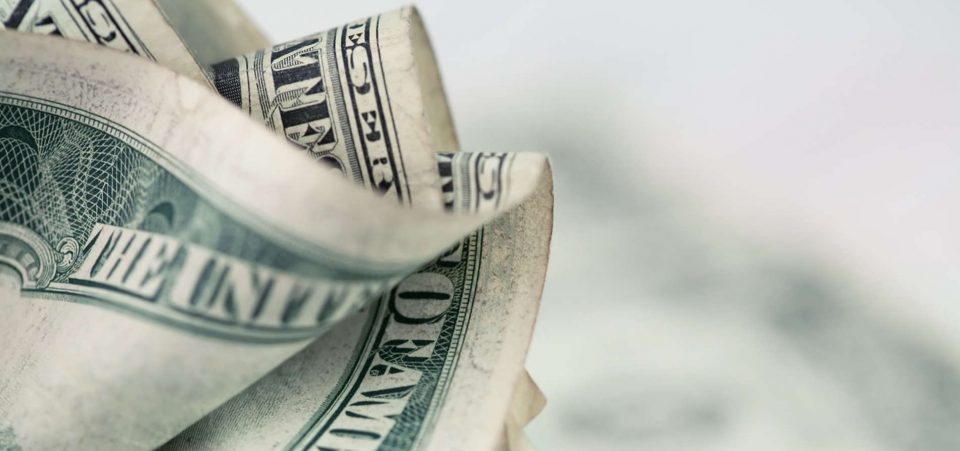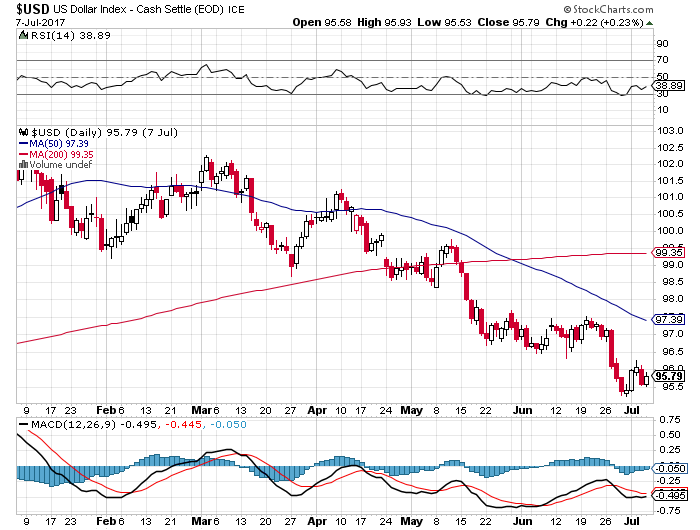U.S. Dollar Forecast for the Next Six Months
Travelers from the United States are about to get a shock. Having gotten used to the purchasing power of their dollar, they have enjoyed advantages just about everywhere in the world. However, that kind of currency dominance is not going to last much longer. The U.S. is on the brink of a dollar collapse over the next six months. Far from benefiting the real economy, a low dollar now would only create more damage.
The Trade Weighted U.S. Dollar Index (TWEXB) clearly shows that the dollar has lost steam since the election of Donald Trump. The index compares the exchange rates of the U.S. currency to the trade-weighted foreign exchange, such as the Mexican peso, Canadian dollar, Chinese yuan, Japanese yen, and euro.
Chart Courtesy of StockCharts.com
By the end of the year, the index had risen to nearly 104, which was the highest since 2002. But now, the dollar index has fallen to about 96. A dollar crash seems likely now, given the risks facing the U.S. economy and rising political instability in Washington. The question now is less “how high can the dollar can reach?” and more “when will the dollar collapse?”
One of the most shocking aspects of the dollar’s recent performance above all is that the Mexican peso has recovered much better than anyone anticipated from the Trump shock. Indeed, the dollar has also lost ground to the euro. The prospect of EUR/USD parity that many predicted—myself included—as a result of the Trump election has vanished.
Good News for American Industry?
The jury is still out on whether a lower dollar might help American industry. If Trump doesn’t disrupt current trade agreements, avoiding the imposition of tariffs—which would be met by reciprocal favors—American industrial products might benefit. However, the lower dollar, especially the kind of low that would result from a dollar crash, might be symptomatic of a bigger problem.
The problem is not so much a lower dollar compared to other currencies. Rather, it’s that the American economy is weaker as well. In addition, the government of Donald Trump is weaker than many had hoped. This suggests that the stock market’s impressive bullish performance since last November could fall, leaving only the echo of a loud thump on Wall Street for investors to remember.
The premise sustaining the stock market’s tremendous bull session was what Trump was going to achieve for business and investors. No doubt, Trump has tried; he has made the proposals that Congress and many voters wanted to hear. The most important of these was, of course, the proposal for a drastic reduction in corporate and income taxes. That should have served to bring back American companies’ operations and individuals’ personal fortunes that are currently abroad.
But, as the “Russiagate” investigation continues, the media and many members of Congress continue to cast doubt on Trump’s legitimacy as president. The evidence for the Russian hacking is spurious at best, yet they insist. The ultimate victim is not even Trump himself; it’s the American people, who can’t seem to catch a break.
America’s perceived political weakness is keeping the dollar under pressure, even as the planned billion-strong tax reduction seems difficult to achieve. Indeed, the tax reduction could, theoretically, overheat the economy and sharply increase inflation. The Federal Reserve would have to slow down the economy by raising interest rates even faster than it has already done. All in all, the return on capital in America would rise more than elsewhere.
But this foundation of the Trump rally, a stronger dollar and a stronger real economy, remains weak for the time being. A strong dollar, meanwhile, would benefit Americans’ purchasing power. Thus, it would help sustain the retail sector. Sears Holding Corp (NASDAQ:SHLD) has recently announced more store closings, just as other major retail chains have already done. That said, it would render American industry less competitive if all other factors stayed equal.
In the short term, Trump might opt to promote competitiveness at the expense of purchasing power. The president would rightly conclude that a lower dollar would strengthen America’s negotiating power in international settings where big deals are signed, such as the G20. But this cannot be achieved without a compromise.
The main risk is that to prevent a dollar crash, the Federal Reserve will become more hawkish in raising interest rates. In turn, the real economy would suffer.







